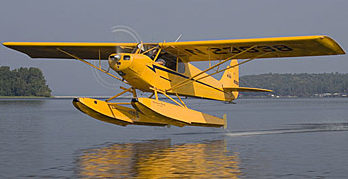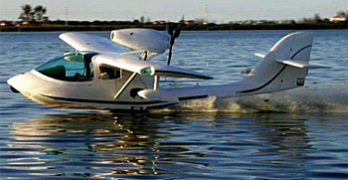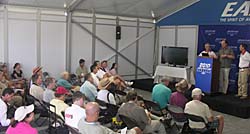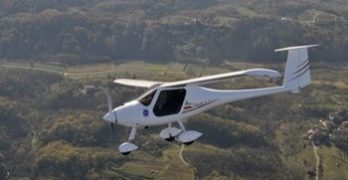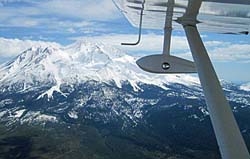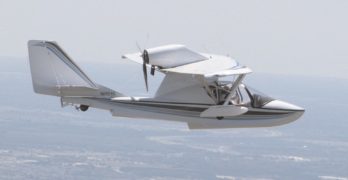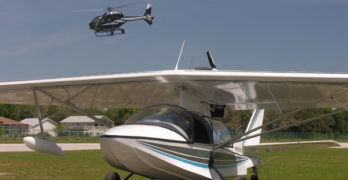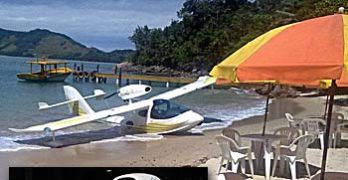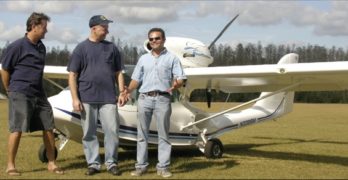Pilots interested in a floatplane LSA and airplane sellers seeking floats lost a good supplier today when Baumann Floats, based at the South St. Paul, Minnesota airport closed its doors. *** In an email, General Manager Joe Birkemeyer wrote, “Due to the unfortunate economic conditions we have all faced in the past couple of years, our current owner of Baumann Floats LLC has decided to discontinue production of all of our float models. The equipment, design data, STCs and inventory will be relocated to Oshkosh, Wisconsin and placed with Basler Turbo Conversions LLC. I personally as well as the rest of my crew will not be moving over to Oshkosh with the company and we will no longer be employed by Baumann Floats LLC. Randy Myers, head of production at Basler Turbo Conversions will be the new interim contact person for any parts orders after April, 1, 2011.
Search Results for : floatplane
Not finding exactly what you expected? Try our advanced search option.
Select a manufacturer to go straight to all our content about that manufacturer.
Select an aircraft model to go straight to all our content about that model.
Landing a Seaplane on Water… with Wheels Down!
Landing on water with your wheels down is a confirmed aviation no-no. Land planes that try it often get flipped over upside down, when escaping the cabin becomes a real concern. Every seaplane pilot I know has a mantra he or she repeats, “I’m landing on water so the wheels must be up.” Most simply don’t want to make this mistake. You can land a seaplane or floatplane on land with the wheels up. The penalty is not as great (and you’ll certainly stop fast). But you violate the wheels-into-water rule at your peril. *** Some airplanes, like the new CTLS on amphib floats, or FPNA’s Capetown, or SeaRey have a light-alert system to help you and some manufacturers offer an audio alarm. Others use mirrors or have other warning systems. *** So why would someone land a SeaMax in water with the wheels down?
New Flight Design Offerings — Summer 2010
Flight Design has maintained their substantial lead in market share partly through a strategy of steady innovation. The German company and its U.S. partners regularly develop new products and introduce them with pizzazz. The company’s press conference and exhibit space at Oshkosh 2010 revealed this methodology. *** AirVenture visitors got to examine the CTLS Lite on amphibious floats. CTLS Lite — unveiled at a significantly-reduced price and dramatically-reduced empty weight — was introduced only three months earlier at Sun ‘n Fun. By Oshkosh 2010, that new model sat atop amphib floats that have already recorded a number of flights from water and land. *** The floats are from Clamar and were developed in concert with Flight Design distributor Airtime Aviation of Tulsa, Oklahoma, arguably the nation’s largest dealer of LSA. “The Clamar floats match the structure and the feel of the Flight Design planes,” said Tom Peghiny, president of importer Flight Design USA.
FPNA A-22 Capetown Amphibian
Capetown RacingLight-sport floatplane that’s a joy to fly
America has far more lakes than airports. By itself, my home state of Minnesota has more lakes than the entire nation has airports. Given this 50:1 advantage, floatplanes or seaplanes make a lot of sense; there are many places you can land, plus you can reach interesting locations you never considered in a land plane.
Lucky me. I’ve gotten to fly lots of light floatplanes and I get a huge smile on my face every time I launch from water or splash down in a lake. The sensation has no match in landplanes. Once you’ve flown a floatplane, you’ll forever look at flying through a new lens.
Imagine flying a mere wingspan above the water, safely|hopping over small islands and zooming down to the water’s surface on the far side, always landing directly into the wind, taxiing up to a dock or beaching on the sand or stopping to do a little fishing while standing on one float.
Oshkosh A-Poppin’
Posting from the road: I’m in Illinois covering a major DC-3 75th Anniversary event for Plane & Pilot for the next couple days, then on up to Oshkosh Airventure for the show all next week. I’ll be posting LSA news from the road but before I head out into the super-humid, super hot thunderstormy day, here’s a couple things to look for if you’re Oshkosh bound: *** LAMA Light Aircraft Manufacturers Association headed by Pres. Dan Johnson expects a robust event schedule for Airventure so I’ll bring you updates whenever possible. *** Some tidbits for what’s to come: *** <> The LSA Mall is full again this year even with the sluggish economy. Here’s who signed up: *** <> Flight Design (CTLS) *** <> Remos (GX) *** <> Piper (PiperSport) *** <> Arion (Lightning LS-1) *** <> Rainbow Aviation / 3Xtrim (Navigator) *** <> Breezer Aircraft (Breezer II) *** <> Pipistrel (Virus) *** <> Hansen Air Group / FK Lightplanes (FK-9 ELA) *** <> Tecnam (P-92 Echo Super) *** <> Evektor (Sportstar) *** <> Jabiru, with two models (J-230 and J-170) *** <> X-Air (LS) *** <> Progressive Aerodyne (SeaRey) *** <> IndUS Aviation’s Thorpedo *** <> Renegade Aircraft (Falcon) *** LAMA also signals a surprise announcement from IndUS at the show. *** Aviators Hot Line, the sponsor of the LSA Mall, has a new “Aviators Helping Aviators” promotion to help LAMA members.
SeaMax Illustrates a Point About Niche LSA
One of the oft-repeated questions about this new thing called Light-Sport Aircraft is: “When will the shakeout occur? When will some of these 75 companies [who certified a SLSA] disappear… and which ones will fail?” *** First, my ability to see the future is no better than anyone else. We’ve lost a few suppliers (Taylorcraft, Urban Air, Spain’s CAG, Higher Class). But as a longtime observer of many sport aviation segments, here’s my view: (1) The current market leaders — the top dozen or so — will likely remain as they’ve already proven themselves. Remember, many overseas brands have world markets so they don’t rely 100% on U.S. sales. And should they fail, it will most likely be due to business practices, not their aircraft design. A few newcomers will enter the top ranks, including such legacy brands as Cessna (which has presently delivered so few Skycatchers that the giant manufacturer is not yet in the Top 20).
New SeaRey: Popular Amphib Goes LSA
Let’s be honest. We’re into flying because we enjoy the experience,
right? Flying light, sporting aircraft is not about flying to work
or transporting goods or people. And if enjoyment is the main
flying goal, then seaplanes are a big part of that pleasure.
Of the LSA-qualified seaplanes covered this year (FPNA Cape Town A-
22 and Airmax SeaMax), the SeaRey is more familiar to readers of Light
Sport and Ultralight Flying magazine and more affordable. The SeaRey
is familiar because of its past in this community. It’s built and it flies as
you’d expect, more so than some $135,000 carbon fiber speedster. It also
costs a great deal less and it’s available as a kit to save even more
dough.
Make no mistake. The SeaRey
LSX (the Experimental-LSA kit
version) and the SeaRey Sport
(the fully-built version in latter
stages of certification) are
advanced light planes, by which I
mean SeaRey has developed significantly
from its simpler 2-
stroke-powered early models.
SeaRey… American-Made Amphibian
SeaRey Sets a New Standard for Floatplanes
Many pilots who have flown in water-borne aircraft believe this is the
finest and most enjoyable flying one can do.
If that statement holds water (is true), then the beautiful SeaRey amphibian
from Florida-based Progressive Aerodyne should be one of the most desirable
aircraft you can buy.
Pilots have spoken with their money. Since it arrived on the market in 1992,
the SeaRey has sold in increasing numbers each year.
Three years of Progressive Aerodyne history hardly tells the story behind
the SeaRey. A father and son ownership team, Wayne and Kerry Richter have
long experience in this business producing many hundreds of amphibious
ultralights.
The Richters were principals in a company called Advanced Aviation best
known for its amphib sea plane called the Buccaneer. After another designer
made the first single place Buccaneer, Kerry Richter made his name with a
two place model.
Seaplane LSA Fun Flying… the Season Approaches
Winter will soon yield to spring and summer, that time of year when flying from water becomes the delight of many pilots who have sampled this pleasure. Competing for their purchase in the LSA space, we have the FK Lightplanes Floatplane, FPNA A-22 Cape Town, and Legend AmphibCub. Other entries include SeaRey (close to declaring ASTM compliance); Mermaid (production plans uncertain), Icon (still in development), Colyaer Freedom (no U.S. representative), plus two trike amphibs with SLSA status (the Krucker Cygnet and Ramphos Trident). *** All this leaves out the SeaMax, which may actually be the strongest player among present SLSA amphibians. Logging its 10th year in 2009 AirMax has produced 98 SeaMaxes for worldwide sale. At $140,000, SeaMax once seemed rather expensive though today, many high-end SLSA command such prices. *** Consider the general appeal of the seaplane or floatplane compared to a land-only flyer.
AirMax SeaMax, Elegant Engineering
Let’s consider light amphibious aircraft – the boathull variety, not floatplanes
– but including both freshly designed, fully built light sport aircraft
along with kit aircraft born of the ultralight heritage.
In the last year, the exceedingly handsome Icon A5 has made quite a splash, literally
and figuratively. However, the A5 is more than a year away from first deliveries
and an order placed today might not be delivered until 2011 or later. Another LSA
amphibian called the Mermaid was designed and introduced by Czech Aircraft
Works of SportCruiser fame. Although five are available in the country, sales have
yet to take off.
Another popular American seaplane, the SeaRey, is moving toward ASTM
approval but remains a kit that asks several hundred hours of a builder’s time. The
simpler and faster-build Aventura models also remain available; this design has
been on the market for many years. Either kit is less costly than a fully built aircraft,
but all seaplanes have loftier price tags to cover their ability to operate on land
or water.
- « Previous Page
- 1
- …
- 3
- 4
- 5
- 6
- 7
- 8
- Next Page »


